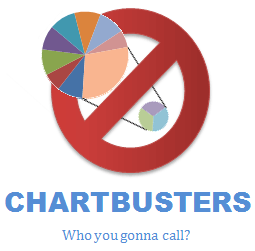Imagine having two annoying little bloggers looking over your shoulder and trying to mess up with the chart you are making….
I am still waiting, go ahead, imagine…
 Now come back, that is exactly what “The Chart DoctorBusters” is all about. It is a new series of posts on PHD and Jon Peltier where we take badly made charts, one at a time and suggest improvements, alternative visualization options and corrective measures.
Now come back, that is exactly what “The Chart DoctorBusters” is all about. It is a new series of posts on PHD and Jon Peltier where we take badly made charts, one at a time and suggest improvements, alternative visualization options and corrective measures.
For a doctor to be really good, he needs to have really sick people. In our case we need bad charts. I mean really bad ones with all those 23 colors or 17 pies or stressful extra grid lines or .. ok, you get the picture.
Here is what you should do:
- Upload your chart or excel workbook to a public site like skydrive.
- Now go to this google docs form and submit your charts
- (alternatively you can tweet us on @r1c1 or @Jon_Peltier)
Here is what Jon and I will do:
Every week we will take one of the really bad charts and post an entire article dissecting the problems and prescribing the treatment. We will take turns, so one week it will be Peltier and next week it will be me. We will also try to comment on each other’s treatment. With some luck, we should get other leading authorities in charting world to come and comment here.
Some rules to keep in mind:
- We are talking about charts here, not complicated dashboards or vibrating visualizations.
- As much as possible try to post the actual data associated with the chart and tell us clearly what you think the chart was trying to achieve.
- Remember, even parapsychologists get psyched.
- Have fun 🙂




















One Response to “SQL vs. Power Query – The Ultimate Comparison”
Enjoyed your SQL / Power Query podcast (A LOT). I've used SQL a little longer than Chandoo. Power Query not so much.
Today I still use SQL & VBA for my "go to" applications. While I don't pull billions of rows, I do pull millions. I agree with Chandoo about Power Query (PQ) lack of performance. I've tried to benchmark PQ to SQL and I find that a well written SQL will work much faster. Like mentioned in the podcast, my similar conclusion is that SQL is doing the filtering on the server while PQ is pulling data into the local computer and then filtering the data. I've heard about PQ query folding but I still prefer SQL.
My typical excel application will use SQL to pull data from an Enterprise DB. I load data into Structured Tables and/or Excel Power Pivot (especially if there's lot of data).
I like to have a Control Worksheet to enter parameters, display error messages and have user buttons to execute VBA. I use VBA to build/edit parameters used in the SQL. Sometimes I use parameter-based SQL. Sometimes I create a custom SQL String in a hidden worksheet that I then pull into VBA code (these may build a string of comma separated values that's used with a SQL include). Another SQL trick I like to do is tag my data with a YY-MM, YY-QTR, or YY-Week field constructed form a Transaction Date.
In an application, I like to create a dashboard(s) that may contain hyperlinks that allow the end-user to drill into data. Sometimes the hyperlink will point to worksheet and sometimes to a supporting workbook. In some cases, I use a double click VBA Macro that will pull additional data and direct the user to a supplemental worksheet or pivot table.
In recent years I like Dynamic Formulas & Lambda Functions. I find this preferable to pivot tales and slicers. I like to use a Lambda in conjunction with a cube formula to pull data from a power pivot data model. I.E. a Lambda using a cube formula to aggregate Accounting Data by a general ledger account and financial period. Rather than present info in a power pivot table, you can use this combination to easily build financial reports in a format that's familiar to Accounting Professionals.
One thing that PQ does very well is consolidating data from separate files. In the old days this was always a pain.
I've found that using SQL can be very trying (even for someone with experience). It's largely an iterative process. Start simple then use Xlookup (old days Match/Index). Once you get the relationships correct you can then use SQL joins to construct a well behaved SQL statement.
Most professional enterprise systems offer a schema that's very valuable for constructing SQL statements. For any given enterprise system there's often a community of users that will share SQL. I.E. MS Great Plains was a great source (but I haven't used them in years).
Hope this long reply has value - keep up the good work.